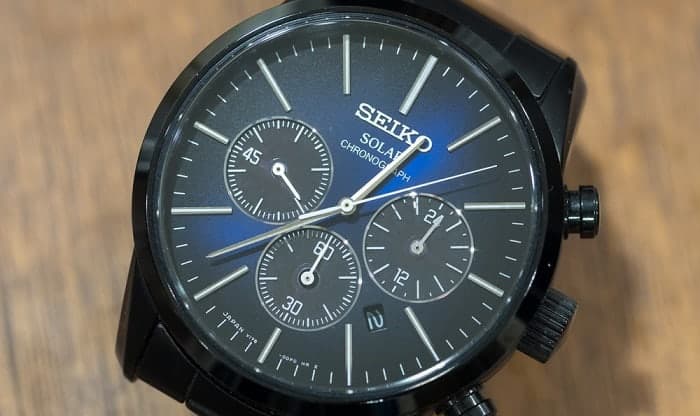Are you planning to buy a solar-powered watch but hesitating because you don’t know much about them? Before buying one, it is just right to discover more if they’re worth investing in or not. The first thing you need to ask yourself is, how do solar watches work?
Solar-powered watches utilize artificial light or the sun’s energy absorbed by the solar panel to run the wristwatch. They convert the captivated light into electrical energy, which is reserved in a rechargeable cell. This means that, unlike other wristwatches, solar watches won’t require daily winding or batteries.
In this article, let’s discover why solar-powered wristwatches are becoming popular and preferred by many people.
Table of Contents
- What is a Solar Watch and Its Primary Features
- How Does It Work
- Do Solar Powered Watches Work with Artificial Light
- Do Solar-Powered Watches Stop Keeping Time in a Dusky Environment
- How Can You Determine the Charge Level of Your Solar Watch
- How Long Will It Take to Charge a Solar Watch
- Are Solar Watches Designed to Last for an Extended Period
- Will Solar Watch Batteries Last Forever
- What are the Upsides and Downsides of Solar Watches
- Final Thoughts
What is a Solar Watch and Its Primary Features
Solar watches come with several photovoltaic cells that are similar to the ones utilized for larger solar panels. Moreover, such timepieces designed for men and women have been mass-produced since the 1970s.
And, since these wristwatches exploit artificial light and the sun’s rays to operate, there’s no need for you to buy a battery or do daily winding.
These watches are commonly engineered to be modern and generally come with several functions.
They are incredibly sturdy, and many models are designed with titanium or stainless steel cases, sapphire crystals, and hardened minerals. Meanwhile, some solar watches come with a blue-gray tint located on the dial purposely for maximizing sunlight.
Nowadays, several solar-powered wristwatches highlight their ruggedness by featuring multiple time-zone displays, stopwatches, and resistance to water up to 200 meters. Some models are also designed with an altimeter and thermometer with LCD display, compass, and even a barometer.
Thus, shoppers searching for more style and functionality will find solar watches a great buy.
How Does It Work
The solar watch’s solar panel is situated chiefly on the face of the wristwatch. As aforementioned, the panel captures artificial light and sunlight, converts the light into electrical energy, and reserves this energy into a rechargeable cell to operate the wristwatch. Sometimes, this technology is called “eco-drive.”
When artificial light or sunlight hits the solar cell, it stimulates an electric current by activating free electrons within the solar panel. Indeed, this electric energy is transferred to a battery, where it is reserved and gradually discharged to run the wristwatch.
Did you notice that solar powered watches are also called solar quartz watches? This is so because the rest of the movement significantly runs in the same manner as a conventional quartz watch. It also features pulsating quartz crystal in the circuit, ensuring a beat rate of one tick per second and precise timekeeping.
Compared to conventional quartz movements designed with disposable batteries, solar wrist watches come with rechargeable batteries, typically in the form of Li-ion cells. You can charge solar watches batteries countless times before a battery replacement is needed.
The delightful news is that a single full charge can generally supply several months’ worth of energy stored, even if the wristwatch is kept in a dusky environment.
Do Solar Powered Watches Work with Artificial Light
While solar-powered wristwatches recharge more excellently in natural lighting conditions, you can also charge such timepieces through a few types of artificial lighting.
There’s no denying that sunlight is unbeatable in producing the quickest charging speeds; however, some radiant artificial light sources could gradually supply sufficient intensity to recharge the solar cell.
Please be guided that it’s helpful to refer to the solar watch’s manual for more details on how your specific watch model responds to distinct lighting conditions. In general, this will vary from model to model. But, as a general rule of thumb, the closer and brighter the light source is to the solar watch, the better.
Do Solar-Powered Watches Stop Keeping Time in a Dusky Environment
No, the best thing about solar watches is that they continuously work from daytime to nighttime. Since the light is kept in a rechargeable cell, the timepiece will remain powered even in the dark.
Interestingly, some solar wristwatch manufacturers utilize li-ion cells that are adept at keeping the timepiece powered for several months without sun or light exposure.
Best of all, solar technology watches are reliable and do not require high maintenance.
Meanwhile, you might also want to watch this very interesting video explaining how to restore a solar watch not working:
How Can You Determine the Charge Level of Your Solar Watch
The majority of solar-powered wristwatches will notify you of their low charge level by their added functionality features. Solar digital wristwatches commonly come with a power level visual indicator as a component of the display. On the other hand, analog wristwatches usually come with certain functions linked with the second hand.
For instance, the ticks may function in bursts of two when the charge level is at a low level. But then again, remember that a solar watch’s function and charge level will vary from model to model. This is why you should keep your manual handy.
How Long Will It Take to Charge a Solar Watch
First and foremost, there are a few factors you’ll need to consider in terms of the duration needed to charge your solar-powered wristwatch fully:
The absorption ability of your solar watch
This factor primarily depends on the model of your solar watch and the technology utilized for the solar panel used on the timepiece.
The intensity of light
Without any doubt, a sunny and bright climate will provide an instant charge to your solar timepiece.
The type of light
Sure thing, if you’re going to compare artificial light and sunlight, the sun’s energy will, of course, ensure a quicker charge to your solar watch.
Are Solar Watches Designed to Last for an Extended Period
Yes, definitely! Solar-powered watches will usually last for a very long time as long as you ensure that they are exposed to light more often. Thanks to their power-reserve capabilities, you won’t even have to worry amidst darkness because they will continue to work.
Such a vital feature enables the timepiece to be in a stable operation for several months and even years without considerable exposure to light.
Will Solar Watch Batteries Last Forever
While solar watches are specifically engineered to stand the test of time, their batteries won’t last forever. This is because the innate nature of cells conveys that, to some extent, the batteries will almost suffer from degradation and corrosion. Over time, with frequent and rugged use, the battery will be exposed to dirt, water, and rust.
There’s no denying that you can keep your solar watch in a dusky spot; nonetheless, it’s best to keep it in a reasonably well-lit location to extend its endurance. Furthermore, this would impede the battery from draining to deficient levels, which could impair its longevity.
What are the Upsides and Downsides of Solar Watches
To help you determine whether solar watches are ideal options, weighing their pros and cons can help you make a well-informed decision.
Upsides of Solar Watches
Eco-friendly
- Help significantly minimize the number of non-biodegradable batteries utilized
Allow a more straightforward charging process
- Charge more excellently with sunlight
- Better option than kinetic timepieces
- Can be charged with any artificial light source
- Merely requires being stored near any light source
For example, a Seiko solar watch battery is one of the most preferred options. Although it’s designed with a built-in power system and is better charged using direct sun exposure, you can charge it using any artificial light source as well.
Maximum Power Reserves
- Specific brands feature power-saving modes
- A three-hour charge can last for roughly six months
Reasonable Investments
- You’ll need to pay a bit expensively at first, but solar watches are not high maintenance
- There are no recurring fees necessary for care and maintenance
- Frequent battery replacements are not required so that you can set aside some extra money.
Reliable, Precise and Flexible
- More accurate than mechanical watches and can fit into a slim watch case
Downsides of solar watches
Many people consider them as pricey investments.
- Solar watches are commonly priced higher compared to other types of watches. But, they are long-lasting, which means you don’t need to buy a new one anytime soon.
Come with visible photovoltaic cells
- Since solar timepieces are engineered with visible PV cells, some models are not appropriate for formal attire.
Lower beat rate
- Solar watches are designed with a lower beat rate than mechanical timepieces.
Are you looking for solar powered products? You can learn more here. Or click here to learn more about the most popular solar refrigerators and solar battery maintainers.
Final Thoughts
Hopefully, this post was able to answer your question, how do solar watches work? You learned in this article that solar-powered watches are eco-friendly, low-maintenance, and reliable timepieces; hence, they are worthwhile and long-lasting investments.
By weighing the pros and cons of using solar watches, you’ll see they’re worth having. The technology behind them is unquestionably stellar, and you could expect that they will continuously upgrade as time goes by.

I am Kathleen Miller, staff writer and reviewer of the Avasolar team. Working with the team has been a pleasure for me so far, I hope to bring readers useful information by creating detailed and easy-to-follow contents.



